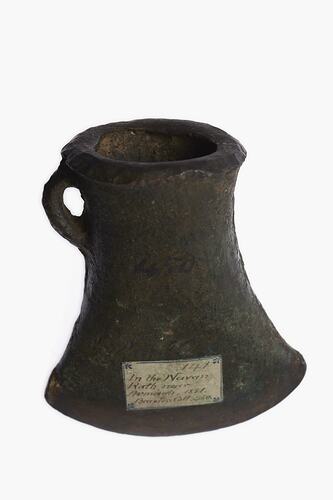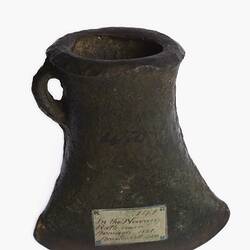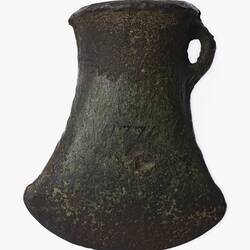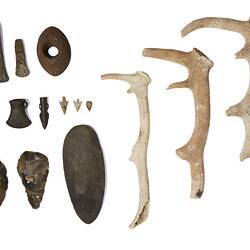Summary
During the Bronze Age, tool makers developed skills with new materials that included copper, gold and bronze (a combination of copper and tin). Using moulds, smiths could make multiple axe heads at once, unlike stone tools. Metal axe technology progressed from a flat style through to a socketed type. The socket would fit over the end of an L-shaped axe handle. The loop was then used to further secure the axe head.
This 'socketed celt' was found in the Navan Rath (Navan Fort) near Armagh in 1851. It entered the ethnological collection (then managed by the National Gallery of Victoria) in 1892, procured by Augustus Wollaston Franks, Keeper of British and Medieval Antiquities and Ethnography at the British Museum, as part of an exchange initiated by the Board of Trustees of the Public Library, Museums and National Gallery of Victoria. The label on this object identifies its source as 'Braxton Coll'. This mysterious figure is likely to be the 'RH Brackstone' noted as the source of collection objects in the British Museum and National Museum of Ireland, with a monogram of 'RHB' also appearing on other Irish objects in the Museums Victoria Collection.
Bibliography
'A guide to British Prehistoric Axes', Museum of Archaeology and Anthrolopology website, Cambridge University, https://maa.cam.ac.uk/files/a_guide_to_british_prehistoric_axes_.pdf, accessed 14 October 2025.
Charles Mount, 'The Collection of Early and Middle Bronze Age Material Culture in South-East Ireland', Proceedings of the Royal Irish Academy. Section C: Archaeology, Celtic Studies, History, Linguistics, Literature, Vol. 101C, No. 1 (2001), pp. 1-35.
Physical Description
A small metal alloy axe with a socket and loop. A label on one side states: "141. In the Navan Rath, near Armagh, 1851. Braxton Coll. 450".
More Information
-
Object/Medium
Axe
-
Maker
-
Locality
-
Date Produced
-
Dimensions
90 (Length), 75 (Width), 45 (Height)
-
Keywords
-
Acquisition Information
Exchange from British Museum, 08 Apr 1892
-
Type of item
-
Discipline
-
Category
-
Collecting Areas



